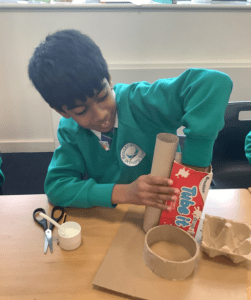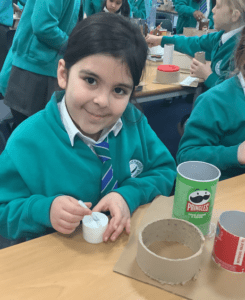Design and Technology
Design & Technology at Broadheath
“Design and Technology should be the subject where mathematical brainboxes and science whizzkids turn their bright ideas into useful products.”
James Dyson
Our intent in Design & Technology
Design and technology is an inspiring, demanding and practical subject. At Broadheath Primary school, our Design and Technology curriculum intends to be inspiring, practical, meaningful and memorable, supporting pupils to develop the growth mindset that they need to Believe, Practise, Succeed. Using creativity and imagination, pupils have the opportunity to design and make products that solve real and relevant problems, within a variety of contexts.
As designers, our pupils will acquire a broad range of subject knowledge and practical skills, drawing on disciplines such as mathematics, science, art engineering and computing. Pupils will work collaboratively to solve problems and learn how to take risks, becoming resilient, resourceful, innovative, and independent learners. Pupils will learn and build on a range of practical and technical skills and knowledge, testing their ideas and critiquing and evaluating both their own products and the work of others.
How we Implement our Design & Technology curriculum
At Broadheath Primary, Design and Technology units complement other subject topics taught in Geography, History and Science, establishing real contexts for the children’s work. We utilise the Projects on a Page scheme of work, which is taught in a sequential manner, building on prior learning, and enables pupils to meet the end of key stage attainment targets in the National Curriculum.
Our school’s approaches are informed by current pedagogy and, through a number of adaptive practices, we ensure our Design Technology curriculum is accessible to all pupils. Children are taught to:
Design
- Use research and develop a design-criteria to inform the design of an innovative and appealing product that is fit for purpose.
- Generate, develop, model and communicate ideas through discussion, annotated sketches and diagrams, including cross-sectional diagrams and computer aided design.
Make
- Select from and use a wider range of tools and equipment to perform practical tasks.
- Select from a wider range of construction materials, textiles and ingredients according to functional properties and aesthetic qualities.
Evaluate
- Investigate and analyse a range of existing products
- Evaluate their ideas and products against their own design criteria and consider the views of others to improve their work
Technical Knowledge
- Understand how key events and individuals in design and technology have helped shape the world.
- Apply their understanding of how to strengthen, stiffen and reinforce more complex structures.
- Understand and use mechanical systems in their products
- Understand and use electrical systems in their products
- Apply their understanding of computing to program, monitor and control their products
The Impact of our Design & Technology Curriculum
The intended impact of our curriculum is that every child leaves Broadheath Primary School equipped with the experience and confidence that they can design, create and adapt products collaboratively and strive towards careers incorporating Design and Technology, as skilled, ambitious designers, innovators and developers of the future.
Cultural Capital
Children will learn about key figures and design work, and become increasingly familiar with those who have successfully developed creative, technical and practical expertise within design. We continue to develop partnerships with local businesses and families working within the food and nutrition, marketing, design and engineering sectors, enabling us to bring the outside world into the children’s classrooms to inspire and create memorable learning experiences.
Here are some examples of experiences children at Broadheath have had:
- Visit buildings and places of interest for example Central Library to look at the architecture.
- Visit a local gallery and museum.
- Through visits and visitors become increasingly familiar with Design career opportunities available in the workplace.


